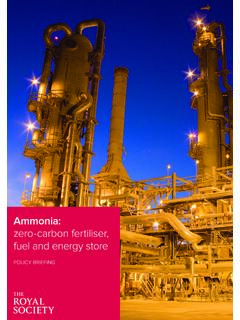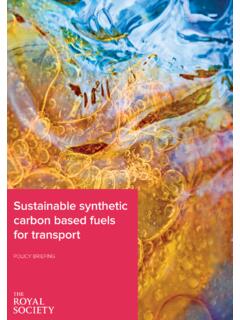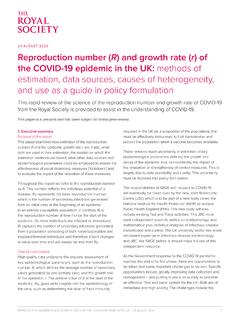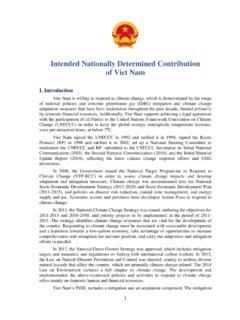Transcription of Options for producing low-carbon hydrogen at scale: Policy ...
1 Options for producing low- carbon hydrogen at scale Policy BRIEFINGC over image: science photo / ShutterstockPOLICY BRIEFINGP olitics and science frequently move on vastly different timescales. A policymaker seeking evidence on a new Policy will often need the answer in weeks or months, while it takes years to design and undertake the research to rigorously address a new Policy question. The value of an extended investigation into a topic cannot be understated, but when this is not possible good evidence is better than none. The Royal Society s series of Policy briefings is a new mechanism aiming to bridge that divide. Drawing on the expertise of Fellows of the Royal Society and the wider scientific community, these Policy briefings provide rapid and authoritative syntheses of current evidence. These briefings lay out the current state of knowledge and the questions that remain to be answered around a Policy question often defined alongside a for producing low- carbon hydrogen at scale Issued: January 2018 DES4801_2 ISBN: 978-1-78252-318-5 The text of this work is licensed under the terms of the Creative Commons Attribution License which permits unrestricted use, provided the original author and source are credited.
2 The license is available at: are not covered by this report can be viewed online at FOR producing LOW- carbon hydrogen AT SCALE 3 CONTENTSC ontentsExecutive Summary 41. Why hydrogen ? 6 Additional considerations for deployment 62. Thermochemical routes to hydrogen 10 Alternative thermochemical processes for hydrogen production 10 Thermochemical challenges and research needs 133. Electrolytic routes to hydrogen 16 Electrolysis challenges and research needs 164. Biological routes to hydrogen 19 Alternative methods for microbial conversion of biomass to hydrogen 20 Biological methods challenges and research needs 205. Solar to fuel routes to hydrogen 22 Solar to fuels challenges and research needs 226. Costs of hydrogen production 25 Financial cost 25 carbon cost 267. Conclusion 27 Annex A: Definitions 29 Annex B: Acknowledgements 314 Options FOR producing LOW- carbon hydrogen AT SCALEEXECUTIVE SUMMARYE xecutive summaryHydrogen has the potential to play a significant role in tackling climate change and poor air quality.
3 It is not a cure all and should be seen as one of the possible pathways to a low carbon energy future. There are barriers to the realisation of a hydrogen -based economy including: production at scale, infrastructure investments, bulk storage, distribution and safety considerations. There is also the issue of how to create a simultaneous demand and supply for hydrogen technologies. This report sets out the best available evidence as to how hydrogen could be produced at a scale useful to power vehicles, heat homes and be used by industry. In doing so it aims to inform those making decisions in areas such as research and innovation funding and the provision of physical infrastructure. By framing the uncertainties around the future uses of hydrogen , it also aims to inform wider discussion on pathways to a low carbon economy The briefing gives an indication of the production technologies, the readiness of each technology, the scale of cost for each and provides insights on the likely source of hydrogen at scale in coming groups of hydrogen production technologies are examined here in order of technology first group of technologies has at its heart a process known as steam methane reforming, which has been used to produce hydrogen from fossil fuels for decades.
4 The process uses natural gas and steam to produce hydrogen . The technology is well understood and is operated on an industrial scale around the world. carbon capture and storage will be essential if this method is to be used to produce low- carbon hydrogen . Emerging thermal methods include microwaving hydrocarbons and the conversion of fossil fuels in the ground to avoid carbon dioxide emissions. Biomass gasification with carbon capture also provides a possible route to reduced carbon FOR producing LOW- carbon hydrogen AT SCALE 5 EXECUTIVE SUMMARYE lectrolysis comprises the second group of technologies. This process separates hydrogen from water using electricity in an electrolysis cell. Electrolysis produces pure hydrogen which is ideal for fuel cell electric vehicles. It has a high efficiency though many current facilities are small. This technology shows great potential to be scaled up and used as a way of converting excess electrical energy produced by renewables into hydrogen , which enables energy storage flexibility.
5 Economic viability relies in part on the availability of sources of low carbon , low cost electricity. The third group is biological methods whose key features are lower operating temperatures and relatively simple technology. These primarily relate to a variation of anaerobic digestion that uses microbes to convert biomass to hydrogen instead of methane, together with emerging biotechnologies that allow a greater hydrogen yield from the original biomass. These microbial processes are being developed at both laboratory scale and at demonstration level and have potential to make a small but valuable contribution to the hydrogen economy. In addition, current research indicates that there is scope for these technologies to play an important role in the production of high value chemicalsThe final group of technologies is known as solar to fuels. This technology harnesses sunlight to split water into hydrogen and oxygen and has been referred to as artificial photosynthesis.
6 Solar to fuels is an active area of scientific innovation, with potential to lead to a disruptive future process; however it is currently a subject of basic research with elements undergoing technological development. There are no current estimates for potential output and questions over ultimate cost and efficiency. This briefing challenges the established view that steam methane reforming is the only solution to producing hydrogen at scale for the next 30 years. The science presented here, tells a different story. Electrolysis has the potential to be deployed to produce low- carbon hydrogen in the near to mid-term alongside steam methane reforming, provided the challenges above are Options FOR producing LOW- carbon hydrogen AT SCALECHAPTER ONEWhy hydrogen ? hydrogen is the most abundant element in the Universe. On Earth, it is found in many chemical compounds, but as a gas it rarely occurs naturally. When generated as a gas it can be used as an energy carrier, which at the point of use produces no carbon dioxide.
7 The large-scale production of low- carbon hydrogen has the potential to play a significant role in tackling climate change and improving air quality. This has two aspects. Firstly, hydrogen is currently used in many industrial processes, and hydrogen production results in the emission of carbon dioxide. producing hydrogen using low- carbon methods therefore has the potential to reduce those emissions. Secondly, using hydrogen as a fuel produces no carbon dioxide, and it can be used flexibly to power transport and decarbonise multiple parts of the energy system including heating buildings. The conversion of the natural gas network to hydrogen and the use of hydrogen in fuel cell electric vehicles could play an important role in reducing overall greenhouse gas emissions and air pollutants. The UK Government s Clean Growth Strategy illustrates a potential hydrogen demand of roughly 700 TWh by 20501 (see annex A for units explanation).
8 There are significant challenges to a hydrogen -based economy including: large-scale capital investments in plant, bulk storage and distribution, safety and security considerations as well as the issue of how to stimulate both demand and supply for hydrogen technologies2. producing hydrogen is energy intensive for most methods of production. Converting between energy states during the production of hydrogen , incurs an efficiency penalty. The more energy conversions that take place between the prime energy source and the final use, the lower the overall system efficiency will be. To overcome these challenges and realise the potential benefits that hydrogen can bring, a holistic consideration of the hydrogen supply chain is needed. This paper focuses on arguably the most challenging barrier to the hydrogen economy producing hydrogen at a range of scales with little or no carbon emissions at acceptable cost. To achieve this, existing technologies need to be decarbonised and new technologies need to be developed (see figure 1).
9 Additional considerations for deploymentThe safe, efficient, effective supply and affordable storage of hydrogen are the main technical challenges associated with the uptake of hydrogen in the energy decision to co-locate the production, storage and end use of hydrogen will be dependent on the technology used. Centralised and decentralised production infrastructure will bring different challenges. Off-grid deployment will tend towards the use of renewables with production facilities on-site, whilst some large urban areas might need large scale hydrogen infrastructure to produce, transport and store quality of hydrogen will be necessary for different uses. For example, some fuel cell types need very pure hydrogen . In these cases, hydrogen will need to be purified at the point of use as it can become contaminated in the pipeline. Additionally, additives may be necessary depending on the circumstances; for example, odorants will be essential to detect HM Government.
10 2017 The Clean Growth Strategy See: (accessed 23 November 2017).2. Brandon N, Kurban Z. 2017 Clean Energy and the hydrogen Economy. Phil. Trans. R. Soc. A 375: 20160400. ( ). Options FOR producing LOW- carbon hydrogen AT SCALE 7 CHAPTER ONEA lkaline electrolyserSolid oxide electrolyser Polymer electrolyte membrane electrolyserELECTROLYTIC ROUTESCoal / biomass gasificationSteam methane reformingTHERMOCHEMICAL ROUTESA utothermal reformingPartial oxidationDownhole conversionMicrowave technologiesALTERNATIVE THERMOCHEMICAL ROUTESP otential components of the low- carbon hydrogen systemFIGURE 1 HydrogenCarbon capture and storageSolar to fuelsAnaerobic digestionPhoto-fermentationBioelectroche mical systemsBIOLOGICAL ROUTESPOWER GRID / RESOURCESENERGY CONVERSION SYSTEMAPPLICATIONR enewable energyFossil fuelsNuclearPower gridBiomassSolarBiorefiningTransportAmmo niaAgricultureHeatingIndustryKEYF uture methodsOther pathways carbon pathwaysCurrent methods Feedstocks Electrical pathways8 Options FOR producing LOW- carbon hydrogen AT SCALECHAPTER ONEA mmonia a resource of growing interest Over 50% of















